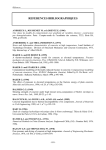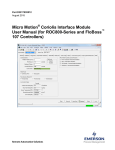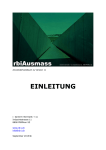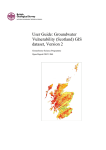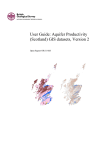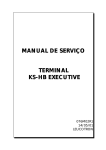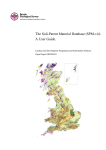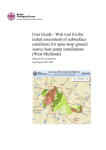Download Non Coal Mining Areas of Great Britain – User Guide
Transcript
User Guide Mining Hazard (not including coal) in Great Britain v1. Contents 1 Introductory Information 1.1 Introduction 1.2 Mining Hazard (not including coal) in Great Britain 2 Technical Information & Use 2.1 Source of information 2.2 Data Structure 2.3 Polygon Information Fields 2.4 Class Descriptions 2.5 Remediation 2.6 Guidance on use of Mining Hazard (not including coal) data 3 Administrative Information 3.1 Copyright 3.2 Contacts User Guide – Non Coal Mining Hazard Areas of Great Britain v1 December 2008 1 INTRODUCTORY INFORMATION 1.1 Introduction Underground extraction of minerals and rocks has taken place in Britain for more than 5000 years. A broad range of different raw materials have been extracted, from precious metals such as gold and silver, to sandstone and gypsum using both surface and underground methods. The voids resulting from past underground mining activity pose a possible hazard. The Mining Hazard (not including coal) in Great Britain data layer draws together a diverse range of material derived from geology, which constrains distribution, supplemented by literature searches for historic locations and expert knowledge to assemble, interpret, and organise this information. Mining of coal is specifically excluded from this data set and enquiries on past coal mining should be directed to the Coal Authority. The information for the various sources has been compiled into a digital format using GIS to create a series of seven separate data layers reflecting distinct categories of mining. Each of these is the result of extensive research, specialist understanding and development and application of an appropriate method of data capture. Information relating to individual polygons is stored in an attribute table and the classifications used are described below. 1.2 Mining Hazard (not including coal) in Great Britain data Scale Dataset Version Comment 1: 50 000 Mining HazardNotIncludingCoalGB V1 Complete 2 TECHNICAL INFORMATION 2.1 Source of Information Polygon outlines derived from BGS 1:50,000 scale DigmapGB data, plus additional information derived from expert knowledge and literature to define areas of potential hazard from past underground mining activity. 2.2 Data structure The data are routinely released in ESRI Arc® shape file formats. Other formats such as MapInfo TAB are available on request. The standard data supplied to customers has polygons or areas in a single layer or theme. 2.3 Polygon information fields Data field Explanation of data field SHAPE Necessary for the ESRI shapefile format indicating polygon data User Guide – Non Coal Mining Hazard Areas of Great Britain v1 Comment December 2008 NAME CLASS This is the site name where available. For some data types for example building stones the sites specific names e.g. Bethel, Draycott-in-the-Moor, Ewe Crag this has been given. For other materials the localities are much more general and many not have details of the site name. This is the case for the majority of localities in which case this field is null. The value in this field represents the overall mining hazard rating for each polygon. It represents the highest hazard value assigned to a polygon regardless of the mining type i.e. a polygon with a building stone rating of B and a vein mineral rating of E is given a class E rating Where more than one name is given e.g. Dalry/Glenarnoch it indicates working of more than one resource type. Note 2 Note 1 For further details see section 2.4 LEGEND COMMODITY Brief description of classes, for more detailed explanation see section 2.4. Where information is available on the commodity worked it is recorded here e.g. Bath stone, limestone, brine. For further details see section 2.5 VERSION If the field is blank details of the mineral mined are not currently available. Note 2 Current version of the data Additional Notes Note 1 If a site lies within a rated polygon, it does not necessarily indicate the presence of mining, rather the likelihood of past mining to have occurred. In these cases it is recommended that further enquiries are made regarding the potential for mining related hazard. Note 2 Where more than one commodity occurs at a location they are both shown e.g. Vein minerals/Building stone. The order also applies to the Name field i.e. Name = Dalry/Glenarnoch Group = Vein Minerals/Building stone Dalry is therefore a vein minerals location whilst Glenarnoch is the building stone name. 2.4 Class Descriptions The classes used to differentiate the areas with different degrees of the likelyhood the existence of underground workings resulting from non-coal mining activities are described below. They are based on a combination of geological factors relating to the known distribution of mineral veins and other commodities that have been mined in the UK supplement by information on known and suspected locations of workings. This is not an assessment of mining instability but identifies the likelihood of the existence past non-coal mining at any particular point. It does not attempt to classify a risk of instability and, even where undermined, the workings may be stable and present no risk of subsidence or be at such a depth that even if collapse has occurred, the surface will not be affected. Even in areas designated with the highest User Guide – Non Coal Mining Hazard Areas of Great Britain v1 December 2008 probability specific sites may not necessarily be undermined. The user is advised to seek further advice on the existence of known workings and, if present, their potential impact on surface stability. Past remedial treatment of sites which may have stabilised previously unstable situations have not been considered during the development of this system for which it is assumed that all locations are un-remediated. The impacts of mining methods, such as roof collapse behind longwall workings, where surface impacts occur within a few years of the mining activities following which surface effects are minimal, have also not been considered. So some high rated areas that have been extensively mined in the past will have an E rating but may not have any surface stability issues as a result of this mining. Unclassified Where unclassified, this means that there is no known hazard from underground mine workings because the rock types present are such that no commodities or metal ores have been worked by underground mining methods.It should be noted, however, that there is always the possibility of the existence of other sub-surface excavations, such as wells, cess pits, follies, air raid shelters/bunkers and other military structures etc. that could affect surface ground stability but which are outside the scope of this dataset. However, you should still find out whether or not a Coal Authority mining search is required in the area. Rare (A) Hazards because of underground mine workings are rare. The rock types present in this area are such that minor mineral veins may be present within them on which it is possible that there have been attempts to work these by underground methods and/or it is possible that small scale underground extraction of other materials may have occurred. All such occurrences are likely to be restricted in size and infrequent.It should be noted, however, that there is always the possibility of the existence of other sub-surface excavations, such as wells, cess pits, follies, air raid shelters/bunkers and other military structures etc. that could affect surface ground stability but which are outside the scope of this dataset. However, you should still find out whether or not a Coal Authority mining search is required in the area. Highly Unlikely (B) Hazards because of underground mine workings may occur. The rock types present in these areas are such that small mineral veins may be present on which it is possible that small scale mining has been undertaken and/or it is possible that limited underground extraction of other materials may have occurred. All such occurrences are likely to be of minor localised extent and infrequent.It should be noted, however, that there is always the possibility of the existence of other subsurface excavations, such as wells, cess pits, follies, air raid shelters/bunkers and other military structures etc. that could affect surface ground stability but which are outside the scope of this dataset. However, you should still find out whether or not a Coal Authority mining search is required in the area. Unlikely (C) Hazards because of underground mine workings are unlikely. The rock types present in these areas are such that mineral veins may be present on which it is possible that User Guide – Non Coal Mining Hazard Areas of Great Britain v1 December 2008 mining has been undertaken and/or it is possible that small scale underground extraction of other materials may have occurred. All such occurrences are likely to be of localised extent and infrequent.It should be noted, however, that there is always the possibility of the existence of other sub-surface excavations, such as wells, cess pits, follies, air raid shelters/bunkers and other military structures etc. that could affect surface ground stability but which are outside the scope of this dataset. However, you should still find out whether or not a Coal Authority mining search is required in the area. Likely (D) Hazards because of underground mine workings are likely. These are areas known or suspected to contain underground mining for minerals and/or other materials. In the case of mineral veins these are areas within 500m of mapped mineral veins within which it is likely that mining activities may have occurred and subsidiary veins explored and exploited.It should be noted, however, that there is always the possibility of the existence of other sub-surface excavations, such as wells, cess pits, follies, air raid shelters/bunkers and other military structures etc. that could affect surface ground stability but which are outside the scope of this dataset. However, you should still find out whether or not a Coal Authority mining search is required in the area. Highly Likely (E) Hazards because of underground mine workings are highly likely. These are areas known or suspected to contain underground mining for minerals and/or other materials where workings are likely to be extensive. In the case of mineral veins these are areas within 200m of mapped mineral veins within which it is likely that mining activities may have occurred. It should be noted, however, that there is always the possibility of the existence of other sub-surface excavations, such as wells, cess pits, follies, air raid shelters/bunkers and other military structures etc. that could affect surface ground stability but which are outside the scope of this dataset. However, you should still find out whether or not a Coal Authority mining search is required in the area. 2.5 Remediation Although there are a number of sites affected by underground mining where remediation has occurred including. parts of the Northwich salt field, Barrow-on Soar, Coalbrookdale, Dudley and Bury St Edmunds, the impact of this remediation work is not considered in this assessment and all ratings are given as if localities are unremediated. 2.6 Guidance on use of Mining Hazard (not including coal) data The observations made in the production of this data are according to the prevailing understanding of the subject at the time. The quality of such observations may be affected by subsequent advances in knowledge, improved methods of interpretation, and access to new source of information. Raw data may have been transcribed from analogue to digital format, or may have been acquired by means of automated techniques. Although such processes are subjected to quality control to ensure reliability where possible, some raw data may User Guide – Non Coal Mining Hazard Areas of Great Britain v1 December 2008 have been processed without human intervention and may in consequence contain undetected errors. Data may be compiled from the disparate sources of information at the BGS's disposal, including material donated to the BGS by third parties, and may not have been subject to any verification or other quality control process. Data, information and related records which have been donated to the BGS have been produced for a specific purpose, and that may affect the type and completeness of the data recorded and any interpretation. The nature and purpose of data collection, and the age of the resultant material may render it unsuitable for certain applications/uses. You must verify the suitability of the material for your intended usage. The data, information and related records supplied by the BGS should not be taken as a substitute for specialist interpretations, professional advice and/or detailed site investigations. You must seek professional advice before making technical interpretations on the basis of the materials provided. If a report or other output is produced for you on the basis of data you have provided to the BGS, or your own data input into a BGS system, please do not rely on it as a source of information about other areas or geological features, as the report may omit important details. Digital data should be used that are fit for purpose and at an appropriate scale, normally at about the same scale as their original compilation, in the case of MiningHazardNot IncludingCoalGB_v1, 1: 50 000, and should not, for example, be enlarged and used at 1: 10 000 scale. If customers are uncertain about the use of particular data they should seek professional advice. They may consult the BGS contacts listed at the end of this document on technical matters, licensing arrangements, or geological aspects including the appropriateness and limitations of the data. 3 ADMINISTRATIVE INFORMATION 3.1 Copyright The copyright of materials derived from the British Geological Survey’s work is vested in the Natural Environment Research Council (NERC). No part of this work may be reproduced or transmitted in any form or by any means, or stored in a retrieval system of any nature, without the prior written permission of the BGS via the BGS Intellectual Property Rights Manager. Copyright and database rights in the BGS dataset are owned by the Natural Environment Research Council (NERC) and licensed to you for your own use only on a non-exclusive basis. Except as necessary for viewing and printing extracts of the data for your own use, you may not copy or adapt the dataset. No part of the dataset may be sold, whether on its own or as part of a value-added commercial product. For extended licence terms, or an interest in the use of the map data for inclusion in commercial products, please contact the BGS Intellectual Property Rights Manager, British Geological Survey, Kingsley Dunham Centre, Keyworth, Nottingham NG12 5GG. Telephone: 0115 936 3331. E-mail: [email protected] The copyright of any coastline supplied with the dataset, or comprising an integral part of the dataset, or derived from the dataset, is vested in the Crown. The user must obtain Ordnance Survey permission to use OS topographic data. User Guide – Non Coal Mining Hazard Areas of Great Britain v1 December 2008 Your use of any information provided by the British Geological Survey (‘BGS’) is at your own risk. Neither BGS nor the Natural Environment Research Council gives any warranty, condition or representation as to the quality, accuracy or completeness of the information or its suitability for any use or purpose. All implied conditions relating to the quality or suitability of the information, and all liabilities arising from the supply of the information (including any liability arising in negligence) are excluded to the fullest extent permitted by law. No advice or information given by BGS, NERC or their respective employees or authorised agents shall create a warranty, condition or representation as to the quality, accuracy or completeness of the information or its suitability for any use or purpose. 3.2 Contacts For further information on MiningHazardNotIncludingCoalGB_v1 please contact the following as appropriate: Availability of Mining Hazrd (not including coal) GB data; Data & technical enquiries; feedback on deficiencies, usage, ways to improve etc. Data & technical enquiries Tel: 0115 936 3545 Mr Richard Shaw email: [email protected] Licensing DiGMapGB data Digital licence enquiries: Digital data delivery Digital data delivery co-ordinator: Mr Christopher P Royles Tel: 0115 936 3012, 3126, 3457 or 3518 email: [email protected] Tel: 0115 936 3389 email: [email protected] Copyright and IPR policy Head, Intellectual Property Rights section Mr Chris Luton Tel: 0115 936 3331 email: [email protected] Digital rights services advisor: Mr Robert J Smith Tel: 0115 936 3508 email: [email protected] BGS address British Geological Survey Keyworth Nottingham NG12 5GG 0115 936 3100 Further information may be accessed through the BGS website: www.bgs.ac.uk — home page for access to all information regarding the BGS and its products and services. User Guide – Non Coal Mining Hazard Areas of Great Britain v1 December 2008









